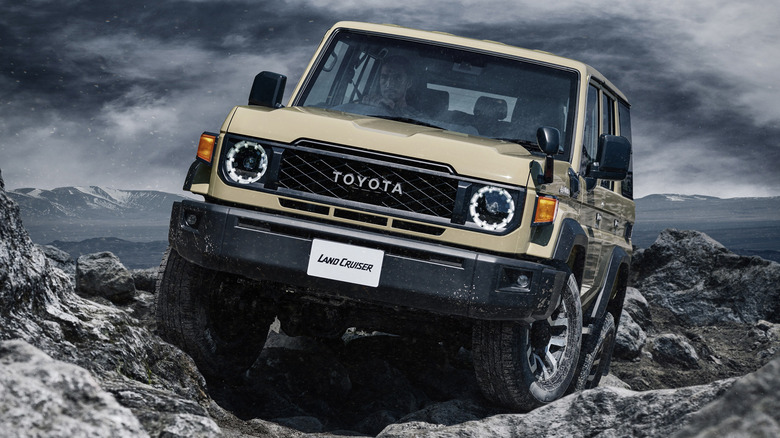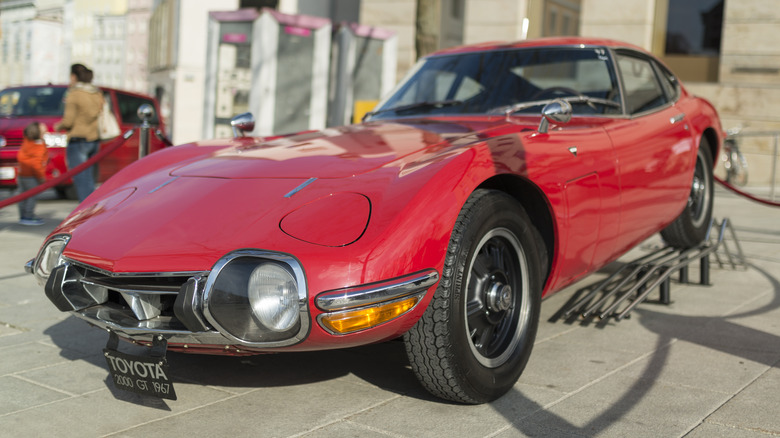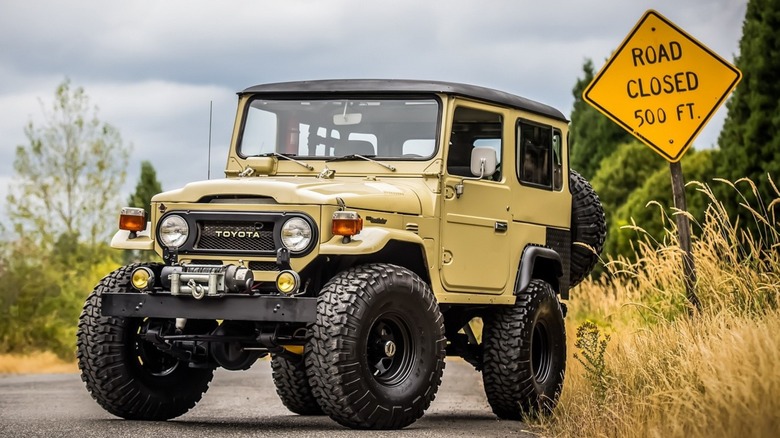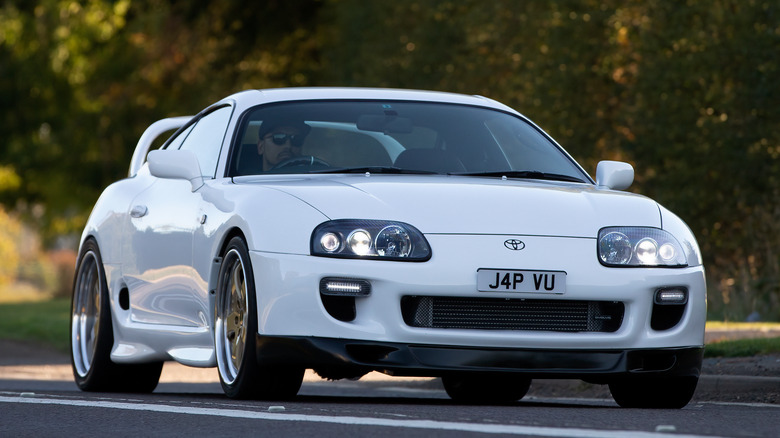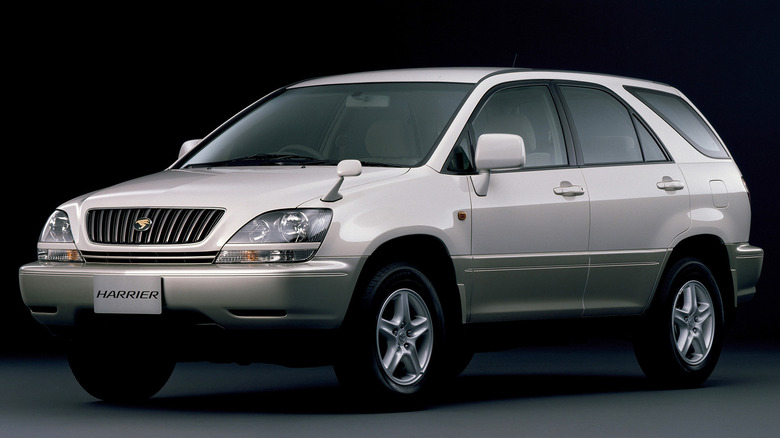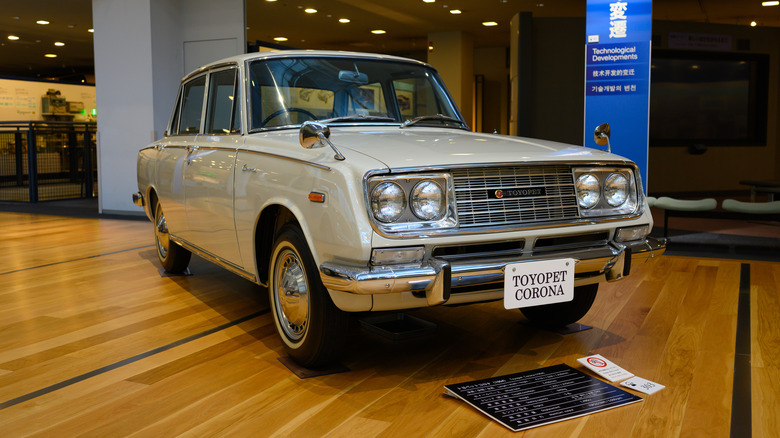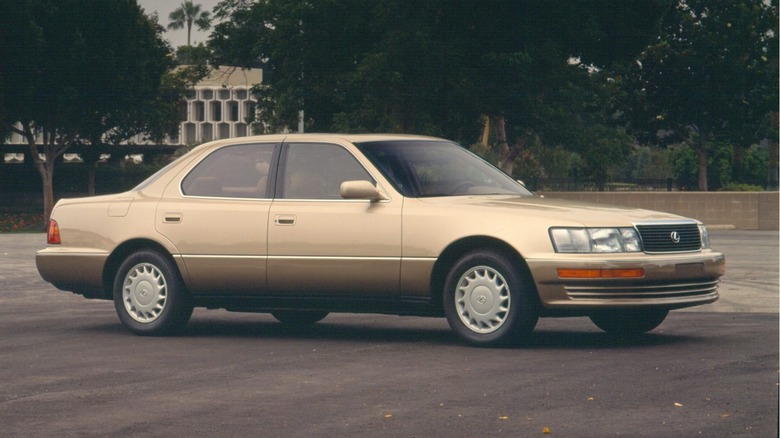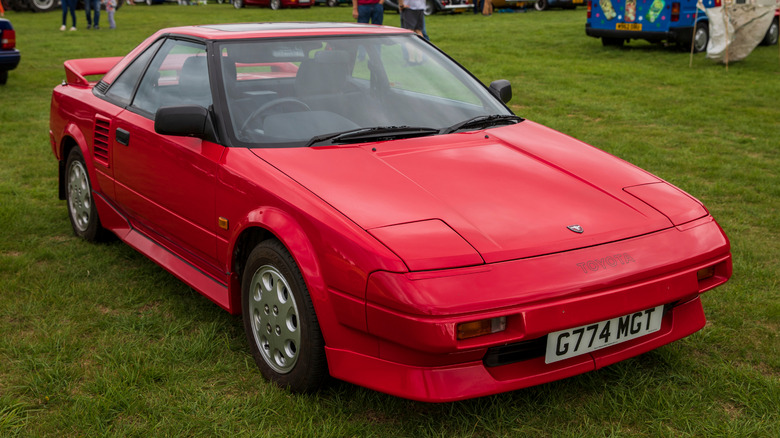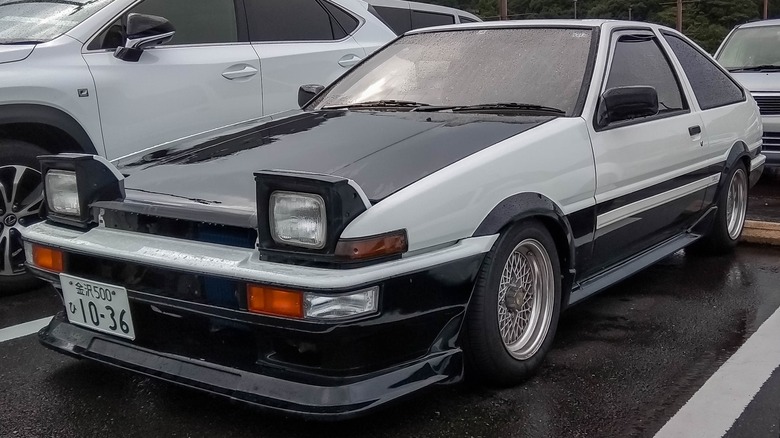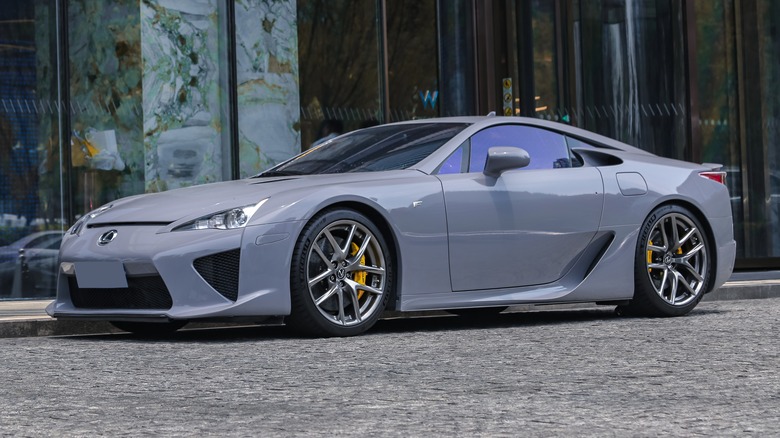The 10 Best Toyotas Ever Designed
Toyota can trace its history back almost one hundred years, when it was originally formed as a division of the Toyoda Automatic Loom Works, a maker of textile looms. Its humble origins make its modern-day status as the world's largest automaker by volume even more impressive, especially given the turmoil brought to the Japanese economy during World War II. The country's postwar recovery saw it transform into a technological and economic powerhouse in just a few decades, and with it, Toyota grew from a small-scale operation into a renowned global carmaker.
That growth would never have been possible were it not for a series of world-beating models that offered superior reliability and capability while undercutting their rivals on price. From off-road stalwarts to luxury sedans, Toyota's back catalog is a huge and varied one. However, there are some models that stand out as being particularly impressive, boasting designs that put them head and shoulders above their competition.
Toyota 2000GT
The 1960s was a decade of transformation for the Japanese car industry. Not only were the country's biggest manufacturers expanding at an unprecedented rate, but there was a newfound interest in motorsports from consumers. This interest spurred Toyota to create its first sports grand tourer, the 2000GT. The automaker didn't have the facilities to develop or construct such a car at the time, and so contracted Yamaha to complete the project.
The first prototype example was unveiled in 1965, but it would take until 1967 for the car to go on public sale. When it did, it was a slow seller, as it launched with a high price that pitted it against sports cars from more established European rivals. In total, around 350 examples of the car would go on to be sold before production ended in 1970.
It might have remained a rare car, but it became well known both at home and abroad. Toyota's extensive testing of the car before its official launch included breaking three world speed records. Not long after it arrived in dealerships, it also arrived on the big screen. In "You Only Live Twice," James Bond, portrayed by Sean Connery, drives an open-top version of the car. The two cars used for filming had to be specially adapted by Toyota, as Connery was reportedly too tall to fit into the regular hardtop car's cabin. Today, the 2000GT is a collectors' grail, with examples regularly fetching over $1 million.
Toyota Land Cruiser 40
The third generation Land Cruiser launched in 1960 with a bevy of improvements over its predecessor, and would prove to be the generation that saw the nameplate achieve global fame. It could trace its roots back to a military truck Toyota had designed in the years following World War II, and much of its rugged, go anywhere capability remained unchanged. However, the 40 Series was also more versatile, with a wider range of body styles on offer. This made it appealing to drivers in harsh environments across the world, from the savannas of Africa to the narrow, unpaved roads of rural Japan.
Over the years, a number of new engine options were also launched, including diesels, which became popular with many buyers thanks to their improved fuel economy. The 40 Series developed a reputation for unbeatable reliability, ensuring it remained popular even though other SUVs offered better performance and more creature comforts until it was eventually discontinued in the mid-1980s.
Toyota Supra MkIV Turbo
The top-spec MkIV Supra should need little introduction to most JDM enthusiasts. It's widely regarded as one of the greatest Japanese cars of its generation, and for good reason. Officially, the car's 2JZ-GTE engine produced 276 horsepower in Japan and 320 horsepower in export markets, but those numbers can be significantly increased with only the simplest modifications. It's not unusual to see more thoroughly overhauled examples boasting power outputs well into four digit territory, but even with just a few bolt-on parts, 400 to 500 horsepower is readily achievable.
The Supra Turbo was no slouch from the factory, however, and could go head-to-head with any car in its class. That included rivals from European manufacturers like Porsche, whose cars cost considerably more to buy upfront yet could be left standing by the Supra. In the years since its unveiling, the Supra Turbo's high-profile appearances in smash hit franchises like "The Fast and the Furious" have helped cement its legacy among younger generations of enthusiasts, although the car itself is now out of reach for most buyers. As clean, original examples get harder to find, resale prices are likely to keep further increasing.
Toyota Harrier/Lexus RX
The Lexus RX crossover, or Toyota Harrier as it was known in Japan, was ahead of its time in terms of both its design and its construction. It launched in the late '90s, when most SUVs were still based on truck platforms. The RX was different in that it was based on the platform of a car –- specifically, it was based on the Camry -– and so offered more car-like driving dynamics than any of its rivals. Better still, it boasted the same level of exceptional reliability as the brand's other offerings.
It proved to be a big hit, especially in North America, where it's credited with kickstarting the luxury soft-roader trend. Its success inspired a new generation of car-based SUVs, many of which wore nameplates that remain in dealerships today. The RX is also still on sale and now in its fourth generation, offering the same blend of generous interior space and refined driving dynamics as it did when it first launched. The large number of first generation cars that can still be found on used car marketplaces is testament to the build quality of the original, which arguably played just as large a part in its popularity as its pioneering design.
Toyota Corona
Toyota's first foray into America was not a successful one. The Toyopet Crown launched in the U.S. in 1957 but was criticized for its poor performance and relatively high starting price compared to its rivals. It sold badly, leaving Toyota in desperate need of a replacement that was better suited to American roads. The Corona, launched in 1965, was a lifeline for the brand, adopting American styling and a larger, more powerful engine. It proved immediately successful, more than tripling the brand's annual sales, and served as an introduction to the Toyota brand for hundreds of thousands of Americans.
It was also successful at home in Japan, where its added power coincided with the opening of the first Japanese expressways. The Corona became the car of choice for Japanese drivers looking to take advantage of the rapidly expanding road network, becoming the first car ever to sell over a million units domestically. Alongside the four-door sedan variants that were most commonly found in America, Japanese buyers could also choose from a lineup of Corona vans, hatchbacks, and pickup trucks. It was succeeded in Japan by the fourth generation Corona in 1970, which carried over many of the car's components but added a new range of engines and styling tweaks.
Lexus LS400
The Lexus LS400 shocked journalists and buyers alike when it debuted in 1989. Toyota was known for making affordable, reliable cars, but the LS400 was a cut above anything the company had made before. It was still competitively priced for its segment, and still fiercely reliable, but it was also just as refined and just as technologically advanced as its leading German competitors. Under the hood sat the 1UZ-FE V8 engine, which had been specially designed for the car.
Toyota had rigorously tested the engine's design before launch, with its engineers racking up a reported one million miles during the development process. The result was a V8 as smooth as anything else on the road, yet one that could run for decades without complaint. The highest mileage examples today are known to have eclipsed the one million mile mark, a remarkable achievement for any car, never mind a luxury vehicle. From a standing start, the LS400 propelled the Lexus brand into the big leagues of luxury carmakers, and forced European and American brands to up their game to compete with the upstart from across the ocean.
Toyota MR2
Mid-engined cars are already a rare breed, but affordable mid-engined cars are even rarer. There are no new examples on sale today, which is why SlashGear has previously argued that it's time for Toyota to resurrect the MR2. The original MR2 was described by reviewers as a parts-bin special, made by combining elements of several existing small Toyotas into one new, innovative design. The finished product was undoubtedly more than the sum of its parts, being one of the most engaging sports cars of its kind yet cheap enough to be within the reach of the average enthusiast.
Its styling was also a success –- the original MR2 even earned the nickname of the poor man's Ferrari, thanks to its low-slung, exotic appearance. Its simple construction also kept maintenance costs a lot lower than any Italian supercar, and its reliability was unsurprisingly superior to boot. The MR2 survived through three generations before being axed in the mid '00s, with no mid-engine successor ever unveiled.
Toyota Land Cruiser 70
Classic nameplates are often brought back by manufacturers, but the vehicles that wear them are almost always new, even if the name isn't. It's almost unheard of for a company to re-introduce a discontinued car without any major updates years after it was discontinued, but that's exactly what has happened with the Toyota Land Cruiser 70. The automaker announced in late 2023 that it was bringing back the classic 70 Series in Japan, almost four decades after the original was launched in 1984.
Only minor changes have been made in the decades since, with the modern Land Cruiser 70 receiving a basic infotainment system and a modern 2.8L turbo-diesel engine. It has also received new headlights and taillights. Other than that, the ladder frame truck is essentially the same as it was when it launched in the '80s. To be fair, this decision wasn't entirely without precedent -– the SUV has remained on sale in select markets like Australia and Africa since it originally launched –- but it's still surprising to see an old car brought back wholesale.
Evidently, there's simply no replacement for such an excellent original design. The Land Cruiser 70 is the vehicle of choice for everyone from safari operators to aid agencies thanks to its uncompromising durability. Given that demand remains so high, it seems set to remain that way for the foreseeable future.
Toyota Corolla AE86
The Toyota Corolla AE86 is an unusual enthusiast car in that, without any context, it isn't very interesting. It's a rear-wheel drive Corolla from the '80s that's not particularly high-powered and doesn't offer anything out of the ordinary for drivers. However, its famed association with Japan's Drift King Keiichi Tsuchiya and subsequent starring role in the "Initial D" manga has firmly cemented its place in JDM pop culture.
Tsuchiya was one of the most instrumental figures in shaping the art of drifting, and was famously seen behind the wheel of his AE86. He later served as an advisor for "Initial D," with many of the stories said to be based on his exploits. The black and white AE86 seen in the manga has become iconic in its own right, while the large aftermarket for the car ensures that there are plenty of other notable AE86 drift builds across the globe.
What was once a humble, overlooked variant of the Corolla has evolved into one of the most tuner friendly Toyota models ever built, and one of the brand's most instantly recognizable cars to JDM fans.
Lexus LFA
Toyota has never been known to shy away from ambitious projects. The company might have made its name with mass-market models, but occasionally it greenlights development on a car unlike anything it's made before. When it does, the results are usually extremely impressive. The Lexus LS400 is one of the most notable examples, alongside another Lexus-branded car – the LFA supercar.
The LFA supercar project originated in the early '00s and became the personal mission of Akio Toyoda, grandson of the founder of Toyota. It was his enthusiastic backing that convinced the board to allocate funds to the car, which would need to be developed from the ground up using cutting-edge materials and manufacturing techniques.
The car boasted a V10 engine and a chassis made from carbon fiber reinforced plastic, both unprecedented steps for Toyota. It was extensively tested on the Nürburgring, with its lead test driver Hiromu Naruse being the mastermind behind its handling. After years of development, the finished car would be not only the most expensive Toyota car ever built but also one of the most exclusive, with only 500 examples made. Today, it's regarded as one of the defining supercars of its era, as well as a milestone for Toyota and for the Lexus brand.
